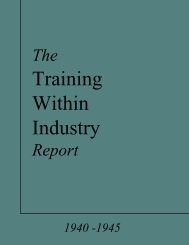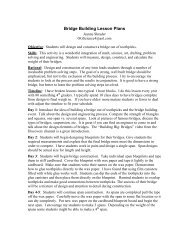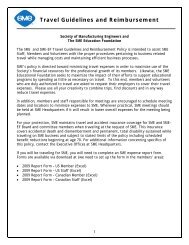Training Within Industry in the United States by Channing R. Dooley
Training Within Industry in the United States by Channing R. Dooley
Training Within Industry in the United States by Channing R. Dooley
Create successful ePaper yourself
Turn your PDF publications into a flip-book with our unique Google optimized e-Paper software.
TRAINING WITIIIN INDUSTRY IN THE UNITED STATES 169<br />
Jon INSTRUCTION CARD<br />
'<br />
HOW TO GET READY<br />
TO INSTRUCT<br />
Hans a Time Table -<br />
how much skill you expect him<br />
to haw!, <strong>by</strong> what date.<br />
Break Dow <strong>the</strong> Job -<br />
list important 6tcps.<br />
pick out <strong>the</strong> key po<strong>in</strong>ts. (Safety is<br />
always a key po<strong>in</strong>t.)<br />
Have Everyth<strong>in</strong>g Ready -<br />
<strong>the</strong> right equipmcnt, materials, and<br />
supplies.<br />
Have <strong>the</strong> Workplace<br />
Properly Arranged -<br />
'ust as <strong>the</strong> worker will be expected to<br />
keep it.<br />
Job Inrtrucfion Traia<strong>in</strong>g<br />
TRAINING WITHIN INDUSTRY<br />
Bureau of Tralnlng<br />
War Manpower Commlsslon<br />
KEEP THIS CARD HANDY<br />
HOW TO INSTRUCT<br />
Steb 1 - Pregare <strong>the</strong> Worker<br />
Put him at ease.<br />
State <strong>the</strong> job and f<strong>in</strong>d out what he<br />
already knows about it.<br />
Get him <strong>in</strong>terested <strong>in</strong> learn<strong>in</strong>g job.<br />
Place <strong>in</strong> correct position.<br />
Step 2 - Present <strong>the</strong> Operation<br />
Tell, show, and illustrate one IM-<br />
PORTANT STEP at a time.<br />
Stress each KEY POINT.<br />
Instruct clearly, con~pletely, and patiently,<br />
but no more than he can master.<br />
Step 3 - Try Out Performance<br />
Have him do <strong>the</strong> job-correct errors.<br />
Have him expla<strong>in</strong> each KEY POINT<br />
to you as he dws <strong>the</strong> job aga<strong>in</strong>.<br />
Make sure he understands.<br />
Cont<strong>in</strong>ue until YOU know HE knows.<br />
Sfep 4 - Follow Up<br />
Put him on his awn. Designate to<br />
whom he goes for help.<br />
Check frequently. Encourage questions.<br />
Taper off extra coach<strong>in</strong>g and close<br />
follow-up.<br />
If Worker Hasn't Learned,<br />
<strong>the</strong> Instructor Has*'; Taught<br />
JOB METHODS CARD<br />
HOW TO IMPROVE<br />
JOB METHODS<br />
A practical plan to hclpyou produce<br />
GREATER QUANTITIES of QUALITY<br />
PRODUCTS <strong>in</strong> LESS TIME, <strong>by</strong> mak<strong>in</strong>g<br />
<strong>the</strong> best use of <strong>the</strong> Manpower, Mach<strong>in</strong>es<br />
and Materials, now available.<br />
STEP I - BREAK DOWN <strong>the</strong> job.<br />
I. List all details of <strong>the</strong> job exactly as<br />
done <strong>by</strong> <strong>the</strong> Present Method.<br />
2. Be sure details <strong>in</strong>clude all:<br />
-Material Handl<strong>in</strong>g.<br />
-Mach<strong>in</strong>e Work.<br />
-Hand Work.<br />
STEP I1 - QUESTION every detail.<br />
1. Use <strong>the</strong>se types of questions:<br />
WI-IY is it necessary<br />
WIIAT is its purpose<br />
WHERE should it be done<br />
WHEN should it be done<br />
WHO is best qualified to do it<br />
HOW is <strong>the</strong> "Lest way" to do it<br />
2. Also question <strong>the</strong>:<br />
Materials, Mach<strong>in</strong>es, Equipment,<br />
Tools, Product Design, Layout,<br />
Work-place. Safety, Ilousekeep<strong>in</strong>g.<br />
STEP I11 -DEVELOP <strong>the</strong> new method.<br />
1. ELIMINATE unnecessary details.<br />
2. CO.MBINE details whcn practical.<br />
3. REARRANGE for bettcr sequence.<br />
4. SIMPLIFY all necesanry details:<br />
To make <strong>the</strong> work easier and safer:<br />
-Pre-positlon materials, tools and<br />
equipment at <strong>the</strong> best places <strong>in</strong><br />
<strong>the</strong> proper work area.<br />
-Use gravity-feed hoppers and<br />
drop-delivery chutes.<br />
-I..et both hands do useful work.<br />
-1Jse jigs and fixtures <strong>in</strong>stead of<br />
hands for hold<strong>in</strong>g work.<br />
5. Work out your idea with o<strong>the</strong>rs.<br />
6. Write up your proposed new method.<br />
STEP IV - APPLY <strong>the</strong> new method.<br />
1. Sell your proposal toyour "boss."<br />
2. Sell <strong>the</strong> new method to <strong>the</strong> operators.<br />
3. Get f<strong>in</strong>al approval of all concerned<br />
on Safety, Quality, Quantity,<br />
Cost.<br />
4. Put <strong>the</strong> new method to work. Use<br />
it until a better way is developed.<br />
5. Give credit where credit is due.<br />
-








